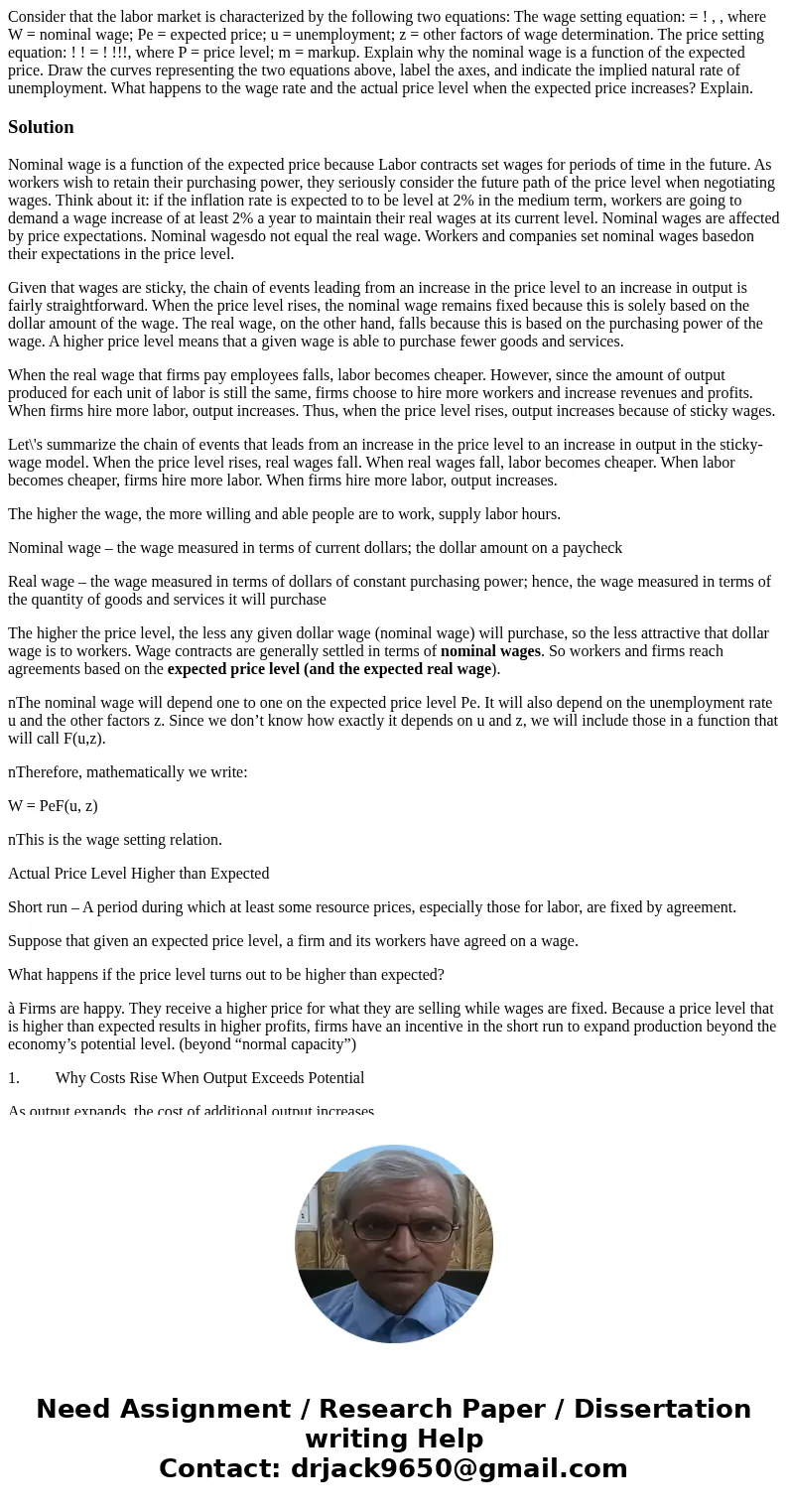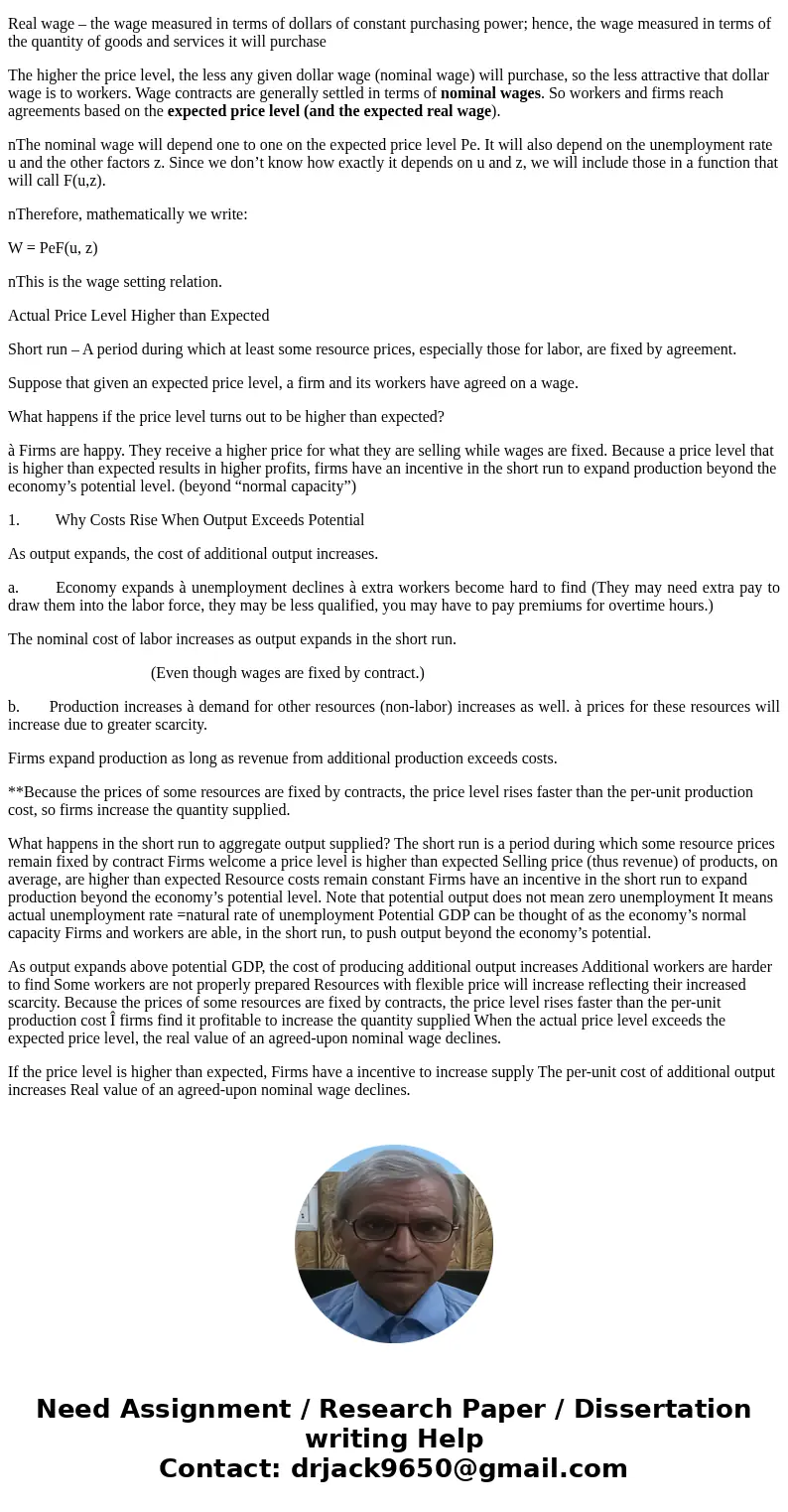Consider that the labor market is characterized by the follo
Consider that the labor market is characterized by the following two equations: The wage setting equation: = ! , , where W = nominal wage; Pe = expected price; u = unemployment; z = other factors of wage determination. The price setting equation: ! ! = ! !!!, where P = price level; m = markup. Explain why the nominal wage is a function of the expected price. Draw the curves representing the two equations above, label the axes, and indicate the implied natural rate of unemployment. What happens to the wage rate and the actual price level when the expected price increases? Explain.
Solution
Nominal wage is a function of the expected price because Labor contracts set wages for periods of time in the future. As workers wish to retain their purchasing power, they seriously consider the future path of the price level when negotiating wages. Think about it: if the inflation rate is expected to to be level at 2% in the medium term, workers are going to demand a wage increase of at least 2% a year to maintain their real wages at its current level. Nominal wages are affected by price expectations. Nominal wagesdo not equal the real wage. Workers and companies set nominal wages basedon their expectations in the price level.
Given that wages are sticky, the chain of events leading from an increase in the price level to an increase in output is fairly straightforward. When the price level rises, the nominal wage remains fixed because this is solely based on the dollar amount of the wage. The real wage, on the other hand, falls because this is based on the purchasing power of the wage. A higher price level means that a given wage is able to purchase fewer goods and services.
When the real wage that firms pay employees falls, labor becomes cheaper. However, since the amount of output produced for each unit of labor is still the same, firms choose to hire more workers and increase revenues and profits. When firms hire more labor, output increases. Thus, when the price level rises, output increases because of sticky wages.
Let\'s summarize the chain of events that leads from an increase in the price level to an increase in output in the sticky-wage model. When the price level rises, real wages fall. When real wages fall, labor becomes cheaper. When labor becomes cheaper, firms hire more labor. When firms hire more labor, output increases.
The higher the wage, the more willing and able people are to work, supply labor hours.
Nominal wage – the wage measured in terms of current dollars; the dollar amount on a paycheck
Real wage – the wage measured in terms of dollars of constant purchasing power; hence, the wage measured in terms of the quantity of goods and services it will purchase
The higher the price level, the less any given dollar wage (nominal wage) will purchase, so the less attractive that dollar wage is to workers. Wage contracts are generally settled in terms of nominal wages. So workers and firms reach agreements based on the expected price level (and the expected real wage).
nThe nominal wage will depend one to one on the expected price level Pe. It will also depend on the unemployment rate u and the other factors z. Since we don’t know how exactly it depends on u and z, we will include those in a function that will call F(u,z).
nTherefore, mathematically we write:
W = PeF(u, z)
nThis is the wage setting relation.
Actual Price Level Higher than Expected
Short run – A period during which at least some resource prices, especially those for labor, are fixed by agreement.
Suppose that given an expected price level, a firm and its workers have agreed on a wage.
What happens if the price level turns out to be higher than expected?
à Firms are happy. They receive a higher price for what they are selling while wages are fixed. Because a price level that is higher than expected results in higher profits, firms have an incentive in the short run to expand production beyond the economy’s potential level. (beyond “normal capacity”)
1. Why Costs Rise When Output Exceeds Potential
As output expands, the cost of additional output increases.
a. Economy expands à unemployment declines à extra workers become hard to find (They may need extra pay to draw them into the labor force, they may be less qualified, you may have to pay premiums for overtime hours.)
The nominal cost of labor increases as output expands in the short run.
(Even though wages are fixed by contract.)
b. Production increases à demand for other resources (non-labor) increases as well. à prices for these resources will increase due to greater scarcity.
Firms expand production as long as revenue from additional production exceeds costs.
**Because the prices of some resources are fixed by contracts, the price level rises faster than the per-unit production cost, so firms increase the quantity supplied.
What happens in the short run to aggregate output supplied? The short run is a period during which some resource prices remain fixed by contract Firms welcome a price level is higher than expected Selling price (thus revenue) of products, on average, are higher than expected Resource costs remain constant Firms have an incentive in the short run to expand production beyond the economy’s potential level. Note that potential output does not mean zero unemployment It means actual unemployment rate =natural rate of unemployment Potential GDP can be thought of as the economy’s normal capacity Firms and workers are able, in the short run, to push output beyond the economy’s potential.
As output expands above potential GDP, the cost of producing additional output increases Additional workers are harder to find Some workers are not properly prepared Resources with flexible price will increase reflecting their increased scarcity. Because the prices of some resources are fixed by contracts, the price level rises faster than the per-unit production cost Î firms find it profitable to increase the quantity supplied When the actual price level exceeds the expected price level, the real value of an agreed-upon nominal wage declines.
If the price level is higher than expected, Firms have a incentive to increase supply The per-unit cost of additional output increases Real value of an agreed-upon nominal wage declines.


 Homework Sourse
Homework Sourse